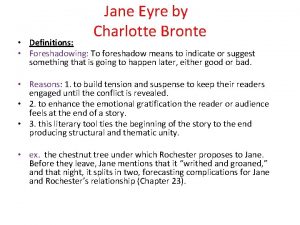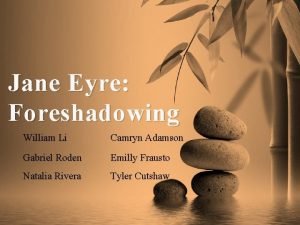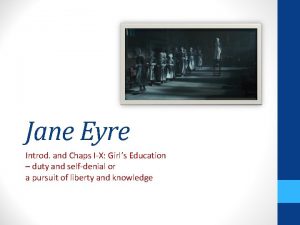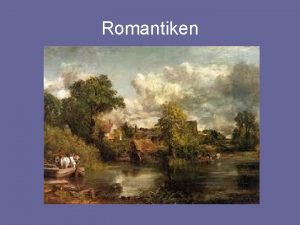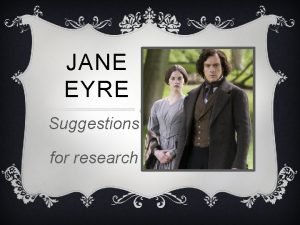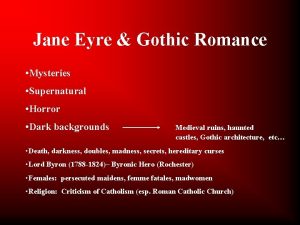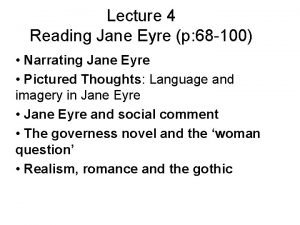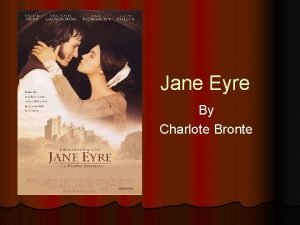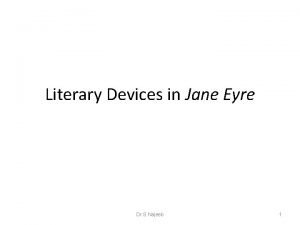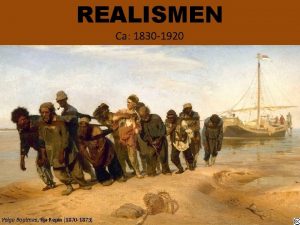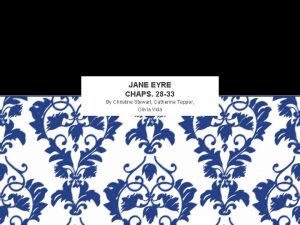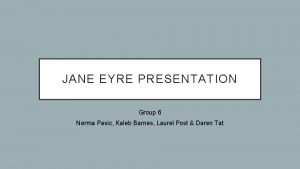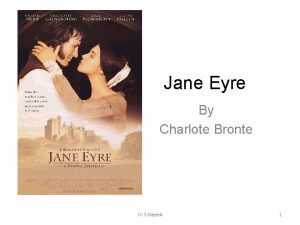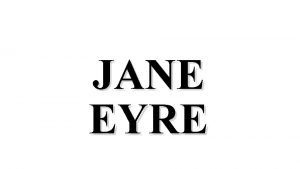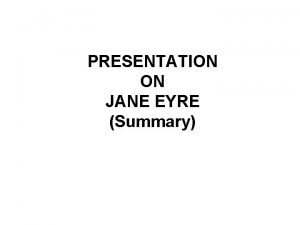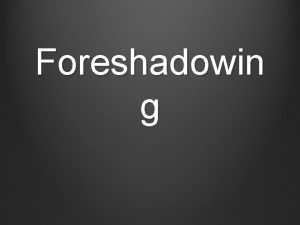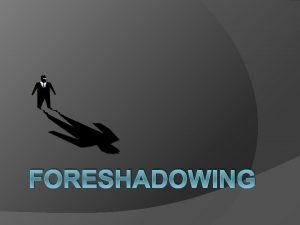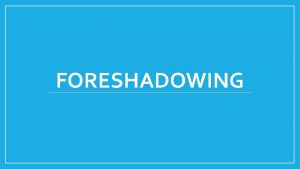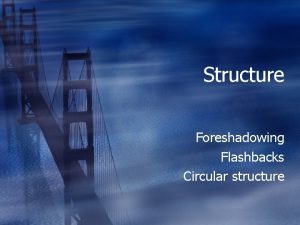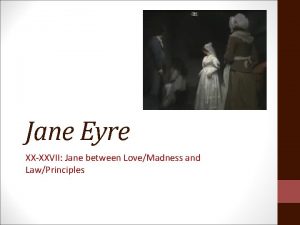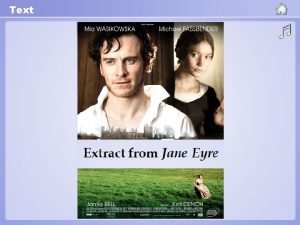Jane Eyre Foreshadowing Element Madeline Evans 1 st












- Slides: 12

Jane Eyre Foreshadowing Element Madeline Evans 1 st Period

Prompt: #39 The Subject of Foreshadowing/presentiment-identify for each passage in the group a: the speaker, b: occasion, and c: explain what the passages have in common in regard to the subject of Jane Eyre- what is theme? a. “Before I left my bed in the morning, little Adele came running to tell me that the great horse chestnut at the bottom of the orchard has been struck by lightning in the night, and half of it split away. ” (Vol. II 257) b. “The cards of address alone remained to nail on: they lay, four little squares, on the drawer. Mr. Rochester had himself written the direction…. I could not persuade myself to affix them, or to have them affixed. Mrs. Rochester! She did not exist; she would not be born till to-morrow, some time after eight o’clock A. M…. ” (Vol. II 275) c. “’Jane!’” d. “’Did you speak these words aloud? ’” e. “’I did…If any listener had heard me, he would have thought me mad; I pronounced them with frantic energy. ’” (Vol. III 447) Foreshadowing is defined as the use of indicative words or phrases and hints that set the stage for a story to unfold and give the reader a hint of something that is going to happen without revealing the story or spoiling the suspense. Used to suggest an upcoming outcome.

Summary of Prompt Answers • A. 1) Jane 2)After Jane & Rochester have confessed their feelings for one another and the chestnut tree has been struck down 3) Natural elements/the supernatural being connected to Jane’s life • B. 1)Jane 2)Jane and Rochester are about to be wed 3)Jane being kept away from secrets that could greatly impact her whole life (Mrs. Rochester DOES exist; she’s in the attic, actually) • C. 1) Rochester 2) Jane is at Moorhouse and Rochester needs her help but they are miles apart 3) Again, Jane’s connection with the supernatural and her undying love for things she cares about • D. 1) Jane 2) Jane and Rochester’s reunion. 3) Supernatural, Jane’s persistent love

The Importance of Foreshadowing and How it is Used in Other Literary Works In other literature, foreshadow has been used as a builder of suspense, placing the reveal or discovery of the foreshadow’s result as the “climax” of the plotline. In Rime of The In Harry Potter and the Sorcerer’s Stone, Prof. Snape tries to embarrass Harry by asking him if he knows where to find a bezoar. In book 6, Ron is poisoned and the bezoar is mentioned as an antidote written in Snape’s handwriting. Harry saves Ron’s life thanks to this. In Beauty and the Beast, the narrator leaves off with “For who could ever learn to love a beast? ” and Belle’s face is shown immediately afterwards Ancient Mariner, the arrival of the menacing ship foreshadows the death of the entire crew, as it is a death ship. .

Quotes In Jane Eyre dealing with Foreshadow • “I saw he was going to marry her, for family, perhaps political reasonsbecause her rank and connections suited him. I felt he had not given her his love…” (Chapter 18, Pg 220) • This foreshadows the fact that Blanche and Rochester will not actually marry. Jane sees that Rochester does not love her; it also reveals Jane’s jealousy and thus her love for Rochester because she is so jealous. This is a short-lived foreshadow, as Jane admits it to herself shortly afterward, but it says something nonetheless. Jane’s observance that Rochester does not truly love Blanche serves to build suspense and indirectly ask rhetorical questions to the audience. Will Blanche and Rochester go through with their marriage? Does Rochester secretly love Jane as much as she loves him? Does Blanche really love Rochester? There are so many questions to be asked wow outstanding rhetoric

Quotes in Jane Eyre dealing with Foreshadow • “’Jane!’” • This quote is really short but it’s very significant in terms of foreshadowing. This is spoken by Rochester and heard by Jane, but it’s when they’re miles and miles apart (she is at Moorhouse at this point). This implies that she has connections with the supernatural (not foreshadow because this has been a recurring theme throughout the novel). This does, however, foreshadow that she will see Rochester soon and especially that he needs her help because of the urgency in his voice. This ties back to Jane’s connection with the supernatural (eg the feelings she had in the Red Room, the connection she feels with her uncle despite not remembering him etc). We later find out that Rochester did actually speak these words and “imagined” hearing a reply when Jane called out, so clearly they have some kind of tie to the supernatural and to each other.

Foil As a Literary Device Supporting a Foreshadow • “’If all the world hated you, and believed you wicked, while your own conscience approved you and absolved you from guilt, you would not be without friends’” (Chapter 8, Pg 83). • Helen Burns (Jane’s first friend as a student at Lowood) serves as a foil to Jane has a nature that is loud and almost attention-seeking (despite good intentions) but Helen’s nature is reserved and self-satisfied. She teaches Jane a lesson that Jane doesn’t understand in her youth but later learns to embrace and believe in. Helen’s words foreshadow Jane learning to be at peace in solidarity later in her adulthood, especially when she is at Moorhouse and has no one whom she considers true family. This also serves true when Jane decides not to marry Rochester based on principle and morals. The old Jane would have perhaps been okay with the marriage because she sought attention and love, but this new Jane is satisfied enough with her own values that she does not need to lower herself to something she feels is immoral. She leaves Rochester, and this is the ultimate demonstration of her personal growth. It started with the foil character, Helen Burns, who is basically a demonstration of older Jane in a childhood friend.

Imagery as a Literary Device Supporting a Foreshadow • Jane has (what she thinks is) a dream after becoming engaged to Rochester. She sees Bertha (whom she does not yet know exists) rummaging through her belongings. She describes Bertha as having purple, bloated skin and matted hair. Essentially she does everything to describe Bertha as more of an animal than a human. This first encounter with Bertha and Rochester’s reaction to it foreshadow the big news that is to come. Bertha and all of Jane’s answers are so tangible now that she has actually seen them; she is having a hard time processing their validity, though. Her graphic description does everything to instill doubts into the reader’s head that it would be a really, really believable dream if it was a dream at all. This is the biggest component of the foreshadow element.

Symbolism as a Literary Device Supporting a Foreshadow • “And what ailed the chestnut tree? It writhed and groaned, while wind roared in the laurel-walk, and came sweeping over us. ‘We must go in, ’ said Mr. Rochester; ‘the weather changes. I could have sat with thee till morning, Jane’” (Chapter 23, Pg 299). • The chestnut tree is symbolism for Jane and Rochester’s planned marriage. Its groaning and splitting in half the next morning is certainly a foreshadow that would not be possible without symbolism. This shows that the natural forces (and perhaps the supernatural) are trying to warn Jane about what lies ahead in her attempted marriage with Mr. Rochester. He has secrets that she does not yet know, and all the elements are coming together to warn her and thus foreshadow that the marriage will not work out. The chestnut tree’s destruction serves as a physical illustration of Jane and Rochester’s relationship after the lightning (that we later find out represents Bertha) comes and strikes it down.

Social Occasion (Wedding) acting as a Revealer and Contribution to the Novel The wedding is really where we see the turning point of Jane Eyre and all the major foreshadow demonstration comes to a peak and is revealed. “Ohhhh that’s why dat tree fel” “o das who laughed al da tyme” Just a lot of questions answered, in short. The wedding hosts the intervention of Mason, the mysterious man who no one really knows anything about until this point. When he reveals that he is Bertha’s brother (and especially that there is a Bertha lol) most of the questions we asked previously are answered.

Significant Moment: The Stolen Corner of Paper St. John sees Jane’s artwork one day and acts very strangely; he tears off a piece of the paper and scurries away like a little hamster or something. Later, he returns to Jane and tells her own life story without him explicitly stating that it’s her life story which is a really weird dynamic if I’m honest. Him stealing her piece of paper foreshadows her identity reveal to both her soon-discovered family and herself. No one would react like that unless they discovered something really interesting on that piece of paper and that’s what St. John has done- he’s found out her real name, Jane Eyre, and recognizes it as the identity of a woman of whom he’s heard.

Citations Bronte, Charlotte. Jane Eyre. New York: Harper Collins. 2010, Print. Literary Devices. Foreshadowing. Literary-devices. com. Accessed 6 January 2018.
